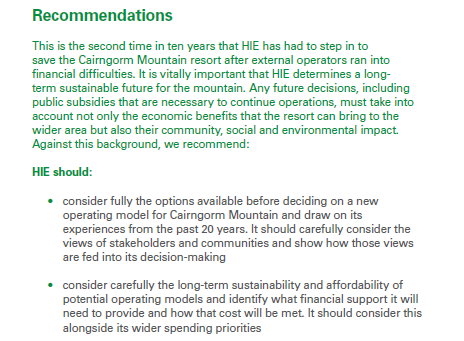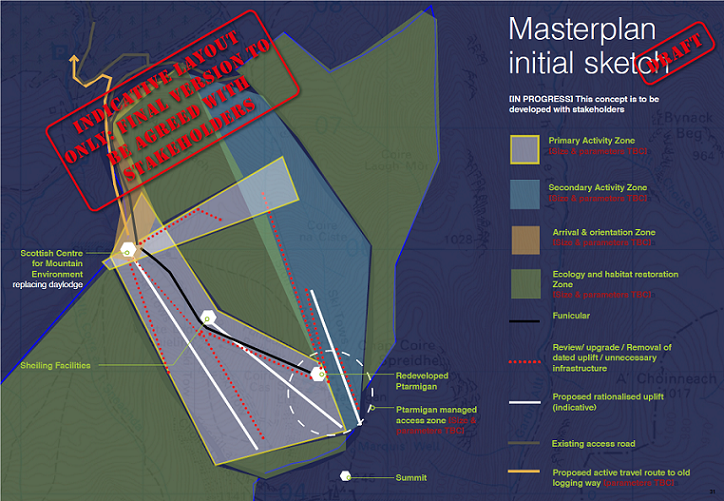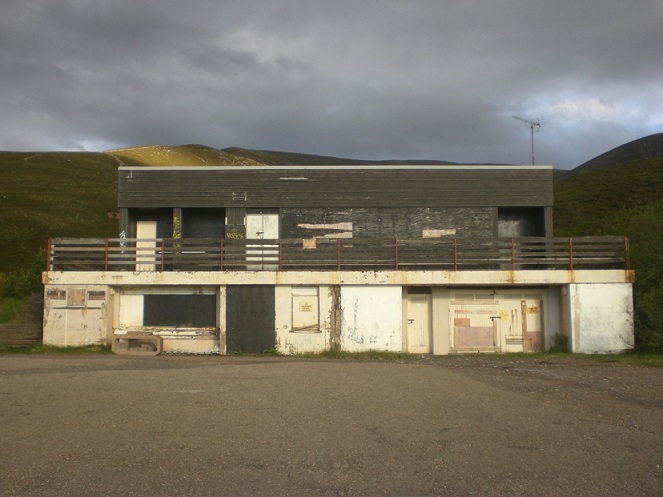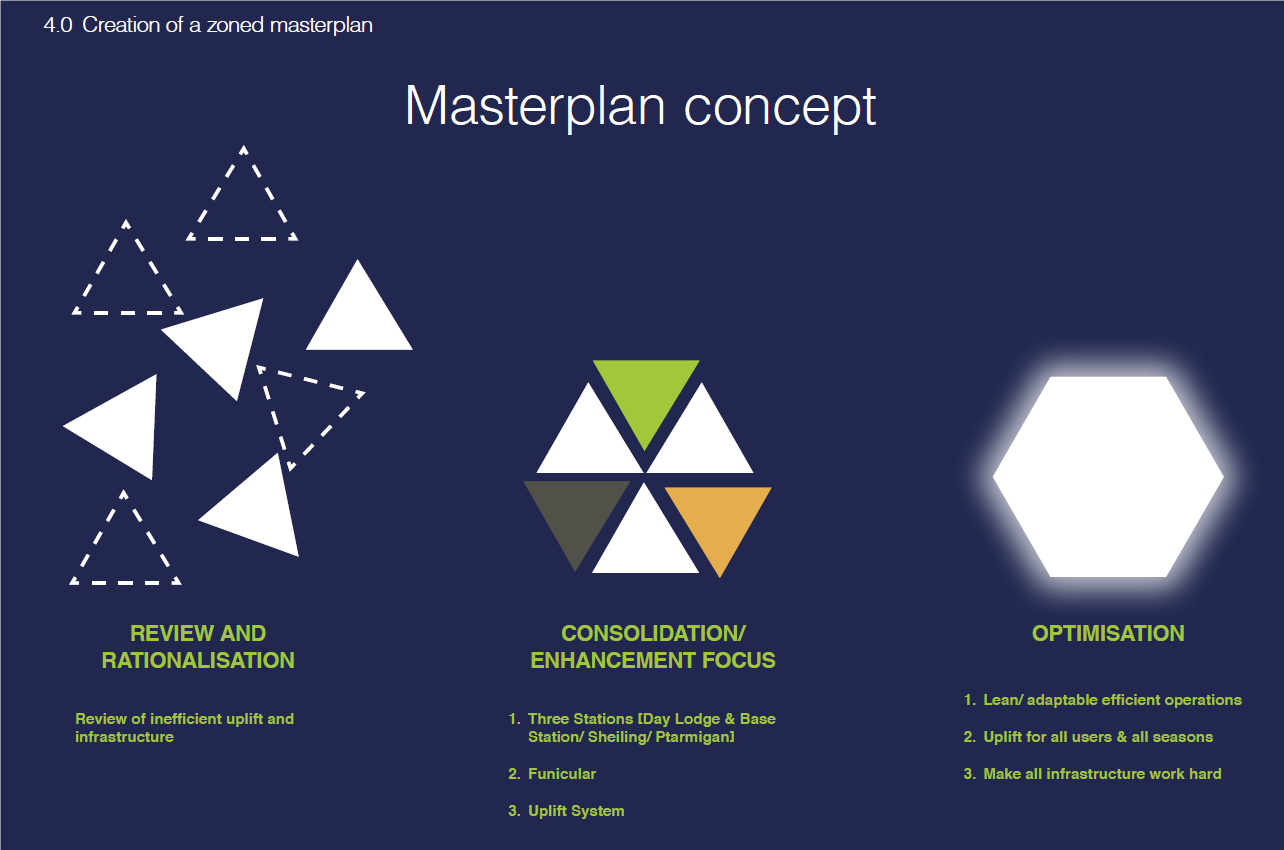Having announced a new masterplan, that wasn’t, in April 2017 (see here) and, eighteen months later, a new £27 million vision that went nowhere (see here), Highlands and Islands Enterprise, without reference to those failures or what could be learned from them, launched at the end of July a consultation called “towards a new vision and masterplan at Cairn Gorm”. This followed a round of engagement conducted by consultants earlier this year (see here). The first assumption set out in the consultation document (see here) is the funicular will continue. That is the key to understanding the document and to how everyone who cares about Cairn Gorm should respond.
HIE built the funicular against the advice of almost everyone who had expertise in mountain recreation, conservation or tourism, and it has never been commercially viable or self-sustaining. Instead of being the salvation of snowsports at Cairn Gorm, as HIE promised, other infrastructure has been axed or abandoned. Cairngorm Mountain’s performance has been abysmal compared to Scotland’s other outdoor snowsports centres which, by contrast, have managed with very little public subsidy. The funicular now lies broken and useless with repair costs estimated at £10-£15m. Given all this, it would be reasonable to expect that HIE might have presented the business case for its repair and fully considered other options as recommended by Audit Scotland in their report in June:
 However instead of doing as Audit Scotland recommended, HIE has turned the funicular into an “assumption”.
However instead of doing as Audit Scotland recommended, HIE has turned the funicular into an “assumption”.
If by whitewashing HIE’s disastrous appointment of “Natural Retreats” (see here) Audit Scotland hoped to make the recommendations in their report more palatable, they have failed completely. Their recommendations have simply been ignored.
The consultation document itself is a mishmash. It is drafted in the the usual management speak. It ticks various government boxes. For example, a quote from soon-to-go Environment Secretary, Roseanna Cunningham, on Climate Change provides the second assumption while the third assumption is a grudging acknowledgement that Cairngorm Mountain sits within a National Park. The “guiding principles” listed in the document, however, bear no resemblance to those contained in the Cairngorms National Park Authority’s Local Development Plan or “Working Principles” for Cairn Gorm (see here). It has no costed proposals, contrary to Audit Scotland recommendations. It mixes up development proposals, which are about planning and land-use, with other ideas (eg building trust) that have nothing to do with what happens on the ground.
Rather than attempting to critique the various elements in what is a mish-mash of principles and strategies – you are asked to wade through them before responding to the consultation – this post will consider the implications that HIE’s Vision, together with the assumption that the funicular will be repaired, has for all the other options at Cairngorm, including the 31 proposals (“activities”) listed in the document. I will argue that what is not said is far more important than what is. That needs to be kept firmly in mind by anyone responding to the online consultation survey (see here) before it closes on 31st August.
The vision
“Cairngorm is an inspiring place and a unique Scottish asset at the heart of a local community”.
At first I thought this vision was meaningless – for “Cairngorm” you could substitute almost anywhere in Scotland – but turn it around and consider the reality:
- Cairn Gorm is a neglected mountain, the developments on it are falling to bits and the land around has been ecologically degraded by mismanagement.
- The funicular is a financial liability, unique almost in the annals of Scottish history – a slight exaggeration, the Darien scheme was worse! – that drains public resources from the rest of the Highlands including the local community in Aviemore.
- HIE have consistently undermined all attempts by the local community or local businesses to get involved in its management.
So, perhaps the vision is not quite so vacuous as I thought on a first reading? How then does HIE intend to achieve this visionary turnaround?
“We will respect, sustain and enhance Cairngorm as a world-class mountain environment where nature thrives and people of all ages and abilities enjoy access to outdoor sport, recreation and
education opportunities in every season of the year”.
No-one would object if, somehow, Cairngorm Mountain could be transformed from fourth rate to world class. But the proposed means of doing this are not as innocuous as they might appear. Enabling “people of all ages and abilities enjoy access to outdoor sport, recreation and education opportunities in every season of the year” is key to HIE retaining the funicular as a grossly subsidised service for older people on bus tours. How else can any older person get to the top of the mountain year round? And it opens the door to covering Cairn Gorm with tube slides, zip wires, artificial ski slopes and mountain coasters to enable children and young people of all ages to enjoy “outdoor sport”.
I am not arguing that the needs of either group aren’t important but Cairn Gorm is not a place for an amusement park and elevating older people up into the clouds will never be much of an experience. The proposals in the document to relax the restrictions around the top of the Ptarmigan and enable people to feel the wind and the cloud first hand, won’t change that.
The masterplan that still isn’t………….
“In broad terms, a masterplan comprises three dimensional images and text describing how an area will be developed. Its scope can range from strategic planning at a regional scale to small scale groups of buildings. Most commonly, it is a plan that describes and maps an overall development concept, including present and future land use, urban design and landscaping, built form, infrastructure, circulation and service provision. It is based upon an understanding of place and it is intended to provide a structured approach to creating a clear and consistent framework for development.” (The Scottish Government see here)
The reason the Cairngorms National Park Authority has been calling for such a masterplan for18 months is because of the endless stream of planning applications at Cairn Gorm over the last few years. Rightly it wants to understand how these all fit together and to be able to determine them within the context of a overall development plan that has been agreed publicly. Instead of a plan, HIE have come up with a draft initial sketch.

The only definite proposal in this sketch is that the funicular will remain.
A second, slightly less concrete proposal, is that the main buildings within the masterplan area, will remain on the existing sites at the Ptarmigan, Shieling and Day Lodge. The proposals to re-develop the Day Lodge as a mountain centre, refurbish the Shieling and extend the Ptarmigan are all extremely vague, there is no mention of costs and no attempt to make a business case.
It is worth recalling that HIE announced the redevelopment of the Day Lodge when they appointed Natural Retreats six years ago. The plan was then dropped, on Natural Retreats’ advice, in favour of extending the Ptarmigan. This, it was thought, might entice some people to buy a funicular ticket. Each development would have been financed by c£3m of public money, included as part of a £4m repayable loan. That indicates that the cost now of upgrading all three buildings would be likely to be at least £7-8m, on top of the £10-15m costs of repairing the funicular. IF the funicular is repaired, it appears very unlikely there will not be enough money to repair or replace all three buildings and there is NO plan B.
 Within the masterplan “sketch” there is strangely no depiction of the derelict building at the bottom of Coire na Ciste. On closer inspection you will see that the whole of the Ciste car park is missing too and both have been left outwith the indicative boundary for the masterplan. This is despite the fact that HIE is ostensibly consulting (Summer Activity 1) on re-purposing the facilities at the base of the Ciste and (Summer Activity 9) on campervan provision at both car parks. This is only explicable if HIE has already made up their mind and Coire na Ciste will form no part of their plans. At least the SE Group Report in 2018 made some attempt to justify why all future development and activity at Cairn Gorm should be based on Coire Cas. HIE hasn’t even bothered. But labelling the Cas as the “primary activity zone” reveals its intentions.
Within the masterplan “sketch” there is strangely no depiction of the derelict building at the bottom of Coire na Ciste. On closer inspection you will see that the whole of the Ciste car park is missing too and both have been left outwith the indicative boundary for the masterplan. This is despite the fact that HIE is ostensibly consulting (Summer Activity 1) on re-purposing the facilities at the base of the Ciste and (Summer Activity 9) on campervan provision at both car parks. This is only explicable if HIE has already made up their mind and Coire na Ciste will form no part of their plans. At least the SE Group Report in 2018 made some attempt to justify why all future development and activity at Cairn Gorm should be based on Coire Cas. HIE hasn’t even bothered. But labelling the Cas as the “primary activity zone” reveals its intentions.
It’s easy to be confused by the differences between the primary and secondary activity zones because, apart from the buildings, the other four elements within them are identical:
• “Uplift modernised and optimised for all activities
• Recreational access
• Diversification of activities accepted
• All activities (winter and summer) to be focused around the uplift system”
Consider, however, the implications of the last bullet “all activities (winter and summer) to be focused around the uplift system” against the sketch of the proposed lifts. It appears there won’t be ANY activity in almost all of Coire na Ciste. Labelling Coire na Ciste as a secondary activity zone therefore appears designed to mislead. This is really important because lower Coire na Ciste is the area at Cairn Gorm which would most lend itself to downhill mountain bike trails. It is no coincidence that HIE includes no proposals for mountain biking WITHIN the “primary activity area”.

The most important proposal for understanding the document – HIE’s real vision – is the idea that “inefficient” infrastructure should be reviewed, the lifts then consolidated and uplift redesigned for all conditions and all users. If implemented, this would continue the disastrous process hat has been going on for years and finish off snowsports at Cairn Gorm. It is, however, full of contradictions:
- The most inefficient uplift on the mountain is the funicular whose design is fundamentally flawed (see here). Yet the funicular has been exempted from any review; it is “assumed”.
- If ALL uplift were to be used, summer and winter, the number of people being taken to the highest and most fragile parts of the mountain would increase many times over (two new chairlifts or gondolas are proposed in addition to the funicular). That would be a disaster for conservation. The implications for the legal Section 50 Agreement which is currently limited to the funicular are not considered.
- Taken to its logical conclusion, the implications of all lift infrastructure being use-able in summer is that HIE sees no place on Cairn Gorm for the existing T-bars and button lifts. Since it is never going to be acceptable, because of the fragile nature of the soils, to replace these lifts in the Ptarmigan bowl with a chairlift that could, say, take mountain bikes, the further implication is that HIE does not see a future for downhill skiing in the Ptarmigan bowl. This is the highest snowfield in Scotland where in terms of global warming, downhill skiing could continue longer than anywhere else. Any coherent plan for new lifts should be based on differential use in summer and winter, rather than making ALL infrastructure working hard.
While the key to the sketch indicates that the lifts marked by red dotted lines will be reviewed and then either upgraded or removed, the strong likelihood is that HIE has already decided to remove them all. That would explain why they are letting them fall into ever greater states of disrepair (post on this coming soon).
The prism of land on the sketch running from the Day Lodge over into Coire na Ciste (the dark blue secondary activity zone) which as been depicted as a separate primary activity zone is puzzling. It gives the impression that some activity might take place there and there will be a connection to Coire na Ciste low down, but none is proposed anywhere in the report.
There are strong hints in the text that accompanies the suggested “activities” as to HIE’s real aspirations for Coire Cas (none of which are depicted on the sketch map):
- First a “Shieling to base artificial slopes would be less intrusive visually, assist with reduced snow cover in winter and maintain the link from the upper slopes to the lower, as well as providing a year-round resource”. That would have a huge impact on the landscape and vegetation in the lower part of Coire Cas, be very problematic in terms of winter skiing (piste bashers don’t go with artificial slopes) but might get people to use the funicular in summer.
- Second a mountain coaster. “SE Group’s proposed coaster requires its own pulley drive system. This goes against the strategy of having all infrastructure based around the proposed uplift system. An alternative could be a linear mountain coaster using a new uplift system. This new
summer activity doesn’t impinge on winter snow sports but maximises a new chair both summer and winter”. How can anyone know it wouldn’t impinge on snowsports unless the sketch plan shows where it and the proposed pistes are to be located?
- Less is said about a zip wire, there is merely a reference to this idea being proposed in the SE Group report (of November 2018 – link above). That is perhaps because a zipwire was the second most unpopular proposal to come out of the consultation earlier in the year. On the one hand this could mean that HIE may have abandoned this stupid idea (the mountain is too cold and windy and icicles dangling from the wires in winter would both create huge safety risks). On the other, however, if HIE is set on transporting large numbers of people up the mountain in summer, it needs something for them to do.
Coupled with the “Introduction Activities” in the Arrival and Orientation zone, i.e the Cas car park and Day Lodge, the impression given is that HIE’s real vision is to turn Coire Cas into a high altitude visitor amusement park whose only real purpose is to keep the funicular going.
Other ideas floated in the plan are hogwash. HIE claims, for example, that it is committed to the business becoming carbon neutral and is now considering renewable options at Cairn Gorm – after refusing to listen to the Save the Ciste Group who had been advocating this for years – but hasn’t even included on the sketch map an indication of where a hydro scheme might go. But perhaps it’s considering a wind turbine?
The proposal to turn the Day Lodge into a Scottish Centre for the Mountain Environment provides cover for all of this, something green sounding to cover the bitter pill. The conservation and recreation organisations that originally suggested this idea did so because they had an alternative vision for Cairn Gorm based on its natural qualities. That vision is nowhere to be seen. HIE’s lack of conservation understanding is illustrated by the large green area in the masterplan labelled “ecology/habitat restoration zone”. Most of this area doesn’t need restoration at all, it is re-wilding very nicely thank you, in large part because HIE keeps out of it. The area that DOES needs restoration is all the damaged ground within the “activity zones” caused by HIE’s mismanagement.
Vision and reality
The masterplan consultation shows that HIE’s vision for Cairn Gorm has been driven by its wish to keep the funicular going, at whatever the cost. HIE knows people don’t use the funicular at present so its new strategy appears to be to try and get more people to use it by linking it and any new lifts to new visitor attractions such as dry ski slopes and mountain coasters. Whether any of this will happen is another matter. The financial costs of repairing the funicular, repairing the buildings and installing new attractions will be phenomenal. That is why it is key that the business case for the repair of the funicular that HIE is due to put to the Scottish Government is subject to public consultation and scrutiny. HIE appears to know that it is unlikely to get all the funding required to realise its vision, hence why it says that at the end of the consultation it will publish:
1. A final vision with guiding principles
2. Key strategies
3. A zoned, adaptable masterplan
“Zoned” and Adaptable” are the key words. Half the snowsports area will be abandoned, but the visitor attractions in Coire Cas need to be adaptable depending on what funding is available. Snowsports will be “retained” but nothing more.
There are alternative visions, which would be far cheaper, far more likely to work and would be far better for the mountain environment. Alan Mackay (see here) and Graham Garfoot (see here) have both described proposals for new uplift infrastructure which are far more detailed than anything HIE included in this consultation. The voluntary organisations last year launched Cairn Gorm: A Vision for the Future. All have been ignored by HIE, except the school for the mountain environment which has been twisted out of all recognition.
The potential for mountain biking on the lower part of mountain has also been disregarded. Bikes of course won’t fit on the funicular. The document contains suggestions for mountain bike runs below the Cas car park but nothing about runs down from half way stations. These would enable some lift use in summer but would also mean designing the infrastructure around skiing and mountain biking rather than attractions like dry ski slopes and mountain coasters.
While this consultation appears to be another farce, it is important people and organisations that care about Cairn Gorm try to respond in order to register objections to the direction of travel. I say “try” because the only official opportunity to do so is through the online questionaire (see here) which allows almost no opportunity for comment. Think carefully about the potential implications of each question before you make your answers. Please also consider sending a letter to HIE (you could try their Chief Executive charlotte.wright@hient.co.uk), copying in local politicians, challenging the assumption that the funicular should be repaired and asking that the business case for this is subject to public scrutiny.

Unusually, I agree with many of your comments about HIE’s latest masterplan. However, once again you play the conservation card. This unprotected area should be used to attract as many visitors as possible. Why is a closed system needed at the Ptarmigan to prevent people visiting the EU designated area which entails a round trip of about 3 kilometres and about 250 metres of ascent, when the public can enter the same designated area within 100 metres at the car park?
To emphasize my point HIE claim 200,000 people a year use the carpark and do other things on the hill. That means 4 million people have probably entered the protected area which is only 100 metres from the carpark since the funicular was opened.
I agree with the funicular being repaired. It is more expensive to remove it. If it was removed there is no guarantee that money would be available to replace it.
A bike track from the Ptarmigan station is a great idea and should be possible. I seem to remember a flat top truck was purchased to transport stores to the Ptarmigan. If I am wrong a truck could easily be obtained.
Hi Ray, clearly in conservation terms, a bike track from the Ptarmigan would be terrible for Cairn Gorm. Your attempt to justify such a facility by saying other parts of the Cairn Gorm estate are close to the protected areas is to ignore completely the difference between the high mountain environment and the ground below the altitudinal limit for trees. The tree and scrub zone – which is now developing – can support far more people than the gravel soils on the higher mountain. That is why the Section 50 limited people coming out of the top of the funicular but not people who might have been attracted to it, thought it was a lousy experience when they saw it and decided to take a walk from the car park instead. Your argument about it being cheaper to repair funicular than remove it ignores the long term and continuing costs of running the funicular and the fact that at some stage – the current need for repairs suggests this will come sooner rather than later – they will reach the end of their life. In other words they will have to be removed anyway or, more likely left on the mountain to rot. It would save £10m + if they were just left to rot now without doing even more damage to the hill. The folly was erecting a structure on the mountain that would be extremely costly to remove – a classic example of unsustainable development. Still, I really appreciate you agree with many of my comments on the masterplan. Cairn Gorm could be a fantastic place if ever the local community and conservation and recreation organisations got together and told HIE enough is enough!
Hi Nick. thanks for your comments.
For those who continue to complain about environmental damage in the unprotected area of Coire Cas, I highlight a quote by Sarah Murray in her travelogue of 1799.
“The top o[ Cairngorm, for the extent of three or four miles, is covered by an irregular bed of large loose stones, having not a grain of soil upon them. This rough bed is a favourite haunt for ptarmigan, which when flying, are the most beautiful birds I ever saw, and their feathers are elegantly marked.”
What has changed?
Hi Ray, this is precisely the point. There is actually some soil on the summit of Cairn Gorm – though Sarah Murray could be excused for not seeing it or the plants that grow in it in 1799 – but its very fragile. It is what helps enable the plants on the plateau to grow through the gravel and between the rocks. Lots of people trampling over it and it breaks down. I have lots of photos showing this and you can track the areas where vegetation has been destroyed that lead out from the Ptarmigan (and also the areas that HIE has from time to time tried to restore with its seed mixes). Take the vegetation away and the gravelly soils erode faster down the hill. Nick